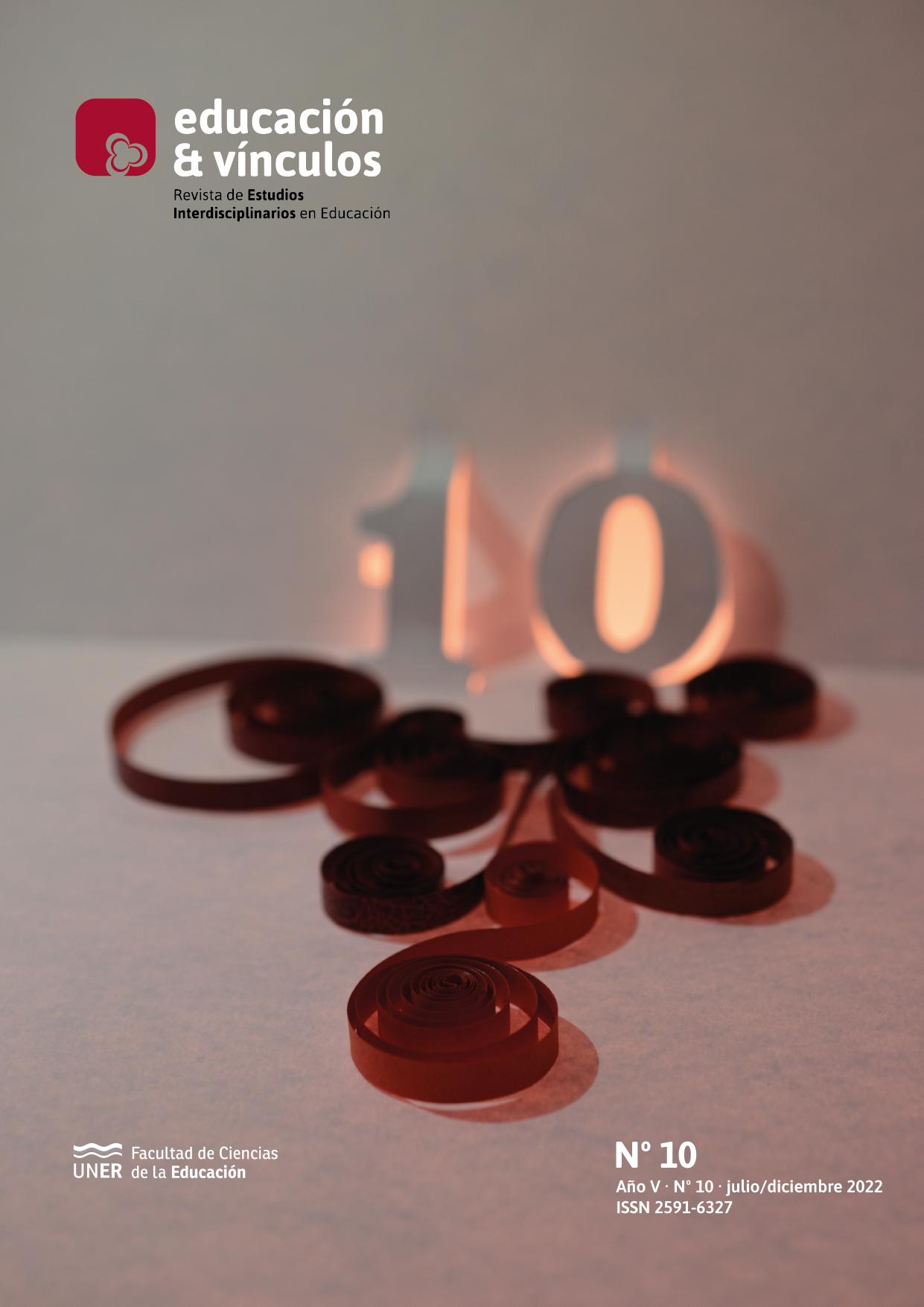Mediatized educational practices of students during the pandemic in a Faculty of Educational Sciences
DOI:
https://doi.org/10.33255/2591/1389Keywords:
COVID-19, university, distance education, university studentsAbstract
This article presents a research on Mediatized Educational Practices implemented in the Faculty of Education Sciences of the National University of Entre Ríos (Argentina) during the period 2020-2021. The study investigated the actions, attitudes and perceptions of students who take traditionally face-to-face courses. For the qualitative analysis, it was implemented a model comprising the Institutional, Social, Technological and Textual dimensions. These dimensions include various technical, organizational, social and cultural factors that shape educational contexts. The main results highlight that during virtualisation students appreciated the possibility of downloading bibliography, the ease of accessing information and the possibility of studying in different places and times. However, the lack of personal interaction with peers and the impossibility to occupy the institution's building discouraged students from staying on the course. In effect, those who had a previous university education were better able to cope with this educational virtualisation. Instead, who had greater difficulties those had less previous experience of face-to-face university life.
Downloads
References
ALCARAZ, M.; Azcárate, M. C. y Aranciaga, I. (2019). Tradiciones de la educación a distancia en universidades nacionales y su vigencia para pensar los desafíos de la expansión y la inclusión. El Cardo, (14), 127-144.
ANDRES, G. y San Martín, P. (2018). Aportes teóricos-metodológicos para el análisis de sostenibilidad socio-técnica de Prácticas Educativas Mediatizadas. Revista de Educación, IX (13), 143-161.
ANDRES, G. y San Martín, P. (2019). Modelo analítico multidimensional para la construcción y la evaluación de prácticas educativas mediatizadas en educación superior. Revista Argentina de Educación Superior, 11 (18), 88-104.
ANDRES, G. y San Martín, P. (2022). Actitudes, habilidades y expectativas de profesores sobre la virtualización educativa durante la pandemia. Sociología y Tecnociencia, 12 (2), 51-72. https://doi.org/10.24197/st.2.2022.51-72
BOJARSKY, G.; Céparo, E. y Cerini, A. (2020). Informe de Síntesis de la Encuesta Institucional para Estudiantes de las carreras de la FCEdu. Paraná: Universidad Nacional de Entre Ríos. Recuperado de: https://www.fcedu.uner.edu.ar/wp-content/uploads/2020/04/informe_fcedu_encuesta.pdf
BOZKURT, A. et al. (2020). A global outlook to the interruption of education due to COVID-19 pandemic: navigating in a time of uncertainty and crisis. Asian Journal of Distance Education, 15 (1), 1-126.
BROWN, C. y Czerniewicz, L. (2010). Debunking the ‘digital natives’: beyond digital apartheid, towards digital democracy. Journal of Computer Assisted Learning, 26 (5), 357-369. https://doi.org/10.1111/j.1365-2729.2010.00369.x
BULLEN, M.; Morgan, T. y Qayyum, A. (2011). Digital learners in higher education: generation is not the issue. Canadian Journal of Learning and Technology, 37 (1), 1-24. https://doi.org/10.21432/T2NC7B
CABERO ALMENARA, J.; Valencia Ortiz, R. y Palacio Rodríguez, A. (2022). La formación virtual en tiempos de COVID-19. ¿Qué hemos aprendido? International Journal of Educational Research and Innovation, 17, 14–26. https://doi.org/10.46661/ijeri.6361
CANO, S.; Collazos, C. A.; Flórez Aristizabal, L.; Moreira, F. y Ramírez, M. (2020). Experiencia del aprendizaje de la Educación Superior ante los cambios a nivel mundial a causa del COVID-19. Campus Virtuales, 9 (2), 51-59.
CARRETERO, M. (1993). Constructivismo y Educación. Paidós. [Fecha de edición: 2016].
DHARWADKAR, K. (2020). Mediatization in higher education towards a new educational paradigm. In: Malobika Routh (ed.). Transition from Traditional Teaching Methodology to Online Teaching. Empyreal Publishing House. 54-64.
DOLCH, C.; Zawacki-richter, O.; Bond, M. y Marín, V. I. (2021). Higher education student’s media usage: a longitudinal analysis. Asian Journal of Distance Education, 16 (1), 31–53. https://doi.org/10.5281/zenodo.4585372
FARNELL, T.; Skledar Matijević, A. y Šćukanec Schmidt, N. (2021). The impact of COVID-19 on higher education: a review of emerging evidence. NESET report. Publications Office of the European Union. https://doi.org/10.2766/069216
FARROW, R.; Iniesto, F.; Weller, M. y Pitt, R. (2020). The GO-GN Research Methods Handbook. Open Education Research Hub. The Open University, UK.
FERNANDEZ, A.M. (2021). Clima emocional en estudiantes universitarios durante la pandemia. Revista de Sociología, 36 (2), 64-75. https://doi.org/10.5354/0719-529X.2021.65604
GALLARDO, E.; Marqués, L.; Bullen, M. y Strijbos, J. (2015). Let’s talk about digital learners in the digital era. International Review of Research in Open and Distance Learning, 16 (3), 156-187. https://doi.org/10.19173/irrodl.v16i3.2196
HANTRAIS, L., et al. (2020). Covid-19 and the digital revolution. Contemporary Social Science. https://doi.org/10.1080/21582041.2020.1833234
KRESS, G. (2010). Multimodality. A social semiotic approach to contemporary communication. Routledge.
MARIN OSSA, D. (2015). La educación mediatizada. Distancias y aproximaciones conceptuales en las metodologías de mediatización del conocimiento. Revista da FAEEBA - Educação e Contemporaneidade. 24 (44), 41-53. https://doi.org/10.21879/faeeba2358-0194.v24.n44.1819
MUIÑOS DE BRITOS, S.; Cambours de Donini, A. y Lastra, K. (2020). De la presencialidad a la virtualidad en la universidad. Desafíos en el escenario de la pandemia en universidades del conurbano bonaerense. Revista de Educación, (22), 265-284.
NARODOWSKI, M.; Volman, V. y Braga, F. (2020). Análisis comparado entre educación pública y educación privada en contexto de COVID-19. Argentinos por la Educación.
ROATTA, S. y Tedini, D. (2021). La pandemia del COVID-19 y el aprendizaje semipresencial en la educación superior. Revista Iberoamericana de Tecnología en Educación y Educación en Tecnología, 28, 318-323. https://doi.org/10.24215/18509959.28.e39
SERRES, M. (2013). Pulgarcita. Fondo de Cultura Económica.
SORGETTI, L.; Schiavinato, N. y Chocobar, T. (2021). Lectura y escritura académica en la virtualidad. Un análisis desde la perspectiva de los estudiantes de Comunicación Social. XXIII Congreso de la RedCom. Universidad Nacional de Entre Ríos.
TEJEDOR, S.; Cervi, L.; Pérez-Escoda, A.; Tusa, F. y Parola, A. (2021). Higher Education Response in the Time of Coronavirus: perceptions of teachers and students and open innovation. Journal of Open Innovation. Technology, Market, Complexity, 7 (1), 43. https://doi.org/10.3390/joitmc7010043
THOMAS, H.; Becerra, L. y Bidinost, A. (2019). ¿Cómo funcionan las tecnologías? Alianzas sociotécnicas y procesos de construcción de funcionamiento en el análisis histórico. Pasado Abierto, 10, 127-158.
UNESCO (2021). ¿Cerrar ahora para reabrir mejor mañana? La continuidad pedagógica en las universidades de América Latina durante la pandemia. París.
XIAO, J. (2021). Decoding new normal in education for the post-COVID-19 world: beyond the digital solution. Asian Journal of Distance Education, 16 (1), 141-155.
ZERILLO, A., Bidiña, A., Espelta, M. y Carra, N. (2021). La lectura académica en entornos virtuales. A propósito del aislamiento social preventivo y obligatorio. Austral Comunicación, 10 (2), 351-373. https://doi.org/10.26422/aucom.2021.1002.zer




